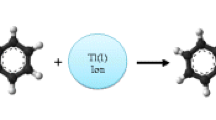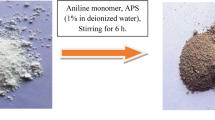Abstract
Branched titanium dioxide nanorods (B-TiO2 NRs) grown on fluorine-doped tin oxide glass (FTO) were developed, which can be used as a solid-phase extractant for preconcentration and determination of trace Pb(II) combined with inductively coupled plasma optical emission spectrometry (ICP-OES). The B-TiO2 NR-based glass substrate displayed excellent adsorptive selectivity and capacity for Pb(II); the maximum adsorption capacity was found to be 168.4 mg⋅g−1 PB(II) at pH = 5.0. It proved that the primary extraction mechanism was attributed to soft acid/soft base interactions to form complexes for chemisorption. Investigating the adsorption kinetics and isotherms indicated that the pseudo-second-order and Langmuir models can better describe Pb(II) adsorption on the B-TiO2 NRs. The proposed method presented good linearity from 0.01 to 5 mg⋅L−1 with a correlation coefficient (R2) of 0.9989 and a low limit of detection (LOD) of 2.2 μg⋅L−1 for Pb(II) under optimal conditions. The method was successfully applied to Pb(II) determination in foodstuffs with desirable recoveries from 93.18 to 108.1% and good precision with an RSD of less than 12.2%. This work provides a new strategy for selective extraction and determination of Pb(II) in complicated matrix samples.
Graphical abstract







Similar content being viewed by others
References
Giri S, Mahato MK, Bhattacharjee S, Singh AK (2020) Development of a new noncarcinogenic heavy metal pollution index for quality ranking of vegetable, rice, and milk. Ecol Indic 113:106214–106223. https://doi.org/10.1016/j.ecolind.2020.106214
He M, Huang L, Zhao B, Chen B, Hu B (2017) Advanced functional materials in solid phase extraction for ICP-MS determination of trace elements and their species—a review. Anal Chim Acta 973:1–24. https://doi.org/10.1016/j.aca.2017.03.047
Tang S, Zhang H, Lee HK (2016) Advances in sample extraction. Anal Chem 88:228–249. https://doi.org/10.1021/acs.analchem.5b04040
Płotka-Wasylka J, Szczepańska N, De La Guardia M, Namieśnik J (2016) Modern trends in solid phase extraction: new sorbent media. TrAC-Trend Anal Chem 77:23–43. https://doi.org/10.1016/j.trac.2015.10.010
Li YH, Ding J, Luan Z, Di Z, Zhu Y, Xu C, Wu D, Wei B (2003) Competitive adsorption of Pb2+, Cu2+ and Cd2+ ions from aqueous solutions by multiwalled carbon nanotubes. Carbon 41:2787–2792. https://doi.org/10.1016/s0008-6223(03)00392-0
Lü M, Li J, Yang X, Zhang C, Yang J, Hu H, Wang X (2013) Applications of graphene-based materials in environmental protection and detection. Chinese Sci Bull 58:2698–2710. https://doi.org/10.1007/s11434-013-5887-y
Samadi N, Hasanzadeh R, Rasad M (2014) Adsorption isotherms, kinetic, and desorption studies on removal of toxic metal ions from aqueous solutions by polymeric adsorbent. J Appl Polym Sci 132:41642–41655. https://doi.org/10.1002/app.41642
Wu Y, Ma Y, Xu G, Xia T, Liu W, Dong Z, Yuan Q, Zhang C, Hu Q (2018) Synthesis of two novel H4TCPBDA-based metal-organic frameworks and their application in lead ion adsorption. J Mater Sci 54:2093–2101. https://doi.org/10.1007/s10853-018-3008-7
Mehdinia A, Heydari S, Jabbari A (2020) Synthesis and characterization of reduced graphene oxide-Fe3O4@polydopamine and application for adsorption of lead ions: Isotherm and kinetic studies. Mater Chem Phys 239:121964–121974. https://doi.org/10.1016/j.matchemphys.2019.121964
Hua M, Zhang S, Pan B, Zhang W, Lv L, Zhang Q (2012) Heavy metal removal from water/wastewater by nanosized metal oxides: a review. J Hazard Mater 211–212:317–331. https://doi.org/10.1016/j.jhazmat.2011.10.016
Xu J, Wu P, Ye EC, Yuan BF, Feng YQ (2016) Metal oxides in sample pretreatment. TrAC-Trend Anal Chem 80:41–56. https://doi.org/10.1016/j.trac.2016.02.027
Liang P, Ding Q, Liu Y (2006) Speciation of chromium by selective separation and preconcentration of Cr(III) on an immobilized nanometer titanium dioxide microcolumn. J Sep Sci 29:242–247. https://doi.org/10.1002/jssc.200500301
Liang P, Liu R (2007) Speciation analysis of inorganic arsenic in water samples by immobilized nanometer titanium dioxide separation and graphite furnace atomic absorption spectrometric determination. Anal Chim Acta 602:32–36. https://doi.org/10.1016/j.aca.2007.09.012
Liang P, Qin Y, Hu B, Li C, Peng T, Jiang Z (2000) Study of the adsorption behavior of heavy metal ions on nanometer-size titanium dioxide with ICP-AES. Fresenius J Anal Chem 368:638–640. https://doi.org/10.1007/s002160000546
Liang P, Shi T, Li J (2004) Nanometer-size titanium dioxide separation/preconcentration and FAAS determination of trace Zn and Cd in water sample. Int J Environ An Ch 84:315–321. https://doi.org/10.1080/03067310310001640456
Zhang L, Zhang M, Guo X, Liu X, Kang P, Chen X (2010) Sorption characteristics and separation of tellurium ions from aqueous solutions using nano-TiO2. Talanta 83:344–350. https://doi.org/10.1016/j.talanta.2010.09.022
Danish EY, Marwani HM, Almoslehi KF, Bakhsh EM (2020) Adsorptive removal of lanthanum based on hydrothermally synthesized iron oxide-titanium oxide nanoparticles. Environ Sci Pollut Res Int 27:5408–5417. https://doi.org/10.1007/s11356-019-07072-z
Xue J, Gao C, Zhang L, Cui K, He W, Yu J (2018) A single-interface photoelectrochemical sensor based on branched TiO2 nanorods@strontium titanate for the detection of two biomarkers. J Mater Chem B 6:4697–4703. https://doi.org/10.1039/c8tb00992a
Wang Y, Ge S, Zhang L, Yu J, Yan M, Huang J (2017) Visible photoelectrochemical sensing platform by in situ generated CdS quantum dots decorated branched-TiO2 nanorods equipped with Prussian blue electrochromic display. Biosens Bioelectron 89:859–865. https://doi.org/10.1016/j.bios.2016.09.106
Liu B, Aydil ES (2009) Growth of oriented single-crystalline rutile TiO2 nanorods on transparent conducting substrates for dye-sensitized solar cells. J Am Chem Soc 131:3985–3990. https://doi.org/10.1021/ja8078972
Wu WQ, Lei BX, Rao HS, Xu YF, Wang YF, Su CY, Kuang DB (2013) Hydrothermal fabrication of hierarchically anatase TiO2 nanowire arrays on FTO glass for dye-sensitized solar cells. Sci Rep 3:1352–1359. https://doi.org/10.1038/srep01352
Liao WP, Wu JJ (2011) Wet chemical route to hierarchical TiO2 nanodendrite/nanoparticle composite anodes for dye-sensitized solar cells. J Mater Chem 21:9255–9262. https://doi.org/10.1039/c1jm10105f
Lee D, Rho Y, Allen FI, Minor AM, Ko SH, Grigoropoulos CP (2013) Synthesis of hierarchical TiO2 nanowires with densely-packed and omnidirectional branches. Nanoscale 5:11147–11152. https://doi.org/10.1039/c3nr02584e
Dhawale DS, Gujar TP, Lokhande CD (2017) TiO2 nanorods decorated with Pd nanoparticles for enhanced liquefied petroleum gas sensing performance. Anal Chem 89:8531–8537. https://doi.org/10.1021/acs.analchem.7b02312
Sun B, Chen Y, Tao L, Zhao H, Zhou G, Xia Y, Wang H, Zhao Y (2019) Nanorod array of SnO2 quantum dot interspersed multiphase TiO2 heterojunctions with highly photocatalytic water splitting and self-rechargeable battery-like applications. ACS Appl Mater Inter 11:2071–2081. https://doi.org/10.1021/acsami.8b18884
Chen J, Yu M, Wang C, Feng J, Yan W (2018) Insight into the synergistic effect on selective adsorption for heavy metal ions by a polypyrrole/TiO2 composite. Langmuir 34:10187–10196. https://doi.org/10.1021/acs.langmuir.8b01987
Luo T, Cui J, Hu S, Huang Y, Jing C (2010) Arsenic removal and recovery from copper smelting wastewater using TiO2. Environ Sci Technol 44:9094–9098. https://doi.org/10.1021/es1024355
Özlem Kocabaş-Ataklı Z, Yürüm Y (2013) Synthesis and characterization of anatase nanoadsorbent and application in removal of lead, copper and arsenic from water. Chem Eng J 225:625–635. https://doi.org/10.1016/j.cej.2013.03.106
Zhang J, Li L, Li Y, Yang C (2017) Microwave-assisted synthesis of hierarchical mesoporous nano-TiO2/cellulose composites for rapid adsorption of Pb2+. Chem Eng J 313:1132–1141. https://doi.org/10.1016/j.cej.2016.11.007
Hu J, Shipley HJ (2012) Evaluation of desorption of Pb (II), Cu (II) and Zn (II) from titanium dioxide nanoparticles. Sci Total Environ 431:209–220. https://doi.org/10.1016/j.scitotenv.2012.05.039
Wu Q, Wu D, Guan Y (2014) Hybrid titania-zirconia nanoparticles coated adsorbent for highly selective capture of nucleosides from human urine in physiological condition. Anal Chem 86:10122–10130. https://doi.org/10.1021/ac502876u
Xie X, Gao L (2009) Effect of crystal structure on adsorption behaviors of nanosized TiO2 for heavy-metal cations. Curr Appl Phys 9:185–188. https://doi.org/10.1016/j.cap.2009.01.035
Wang P, Xu W, Zhou D, Abe M (1991) Ion-exchange selectivities of HTDO for heavy metal ions. J Harbin Inst Technol 23:69–72. https://doi.org/10.1007/BF02945291
Shannon RD (1976) Revised effective ionic radii and systematic studies of interatomie distances in halides and chaleogenides. Acta Cryst 32:751–767. https://doi.org/10.1107/S0567739476001551
Behbahani M, Omidi F, Bide Y, Bagheri S, Nabid MR (2016) A pH responsive nanogel composed of magnetite, silica and poly(4-vinylpyridine) for extraction of Cd(II), Cu(II), Ni(II) and Pb(II). Microchim Acta 183:111–121. https://doi.org/10.1007/s00604-015-1603-8
Moghimi A (2012) Adsorption and preconcentration of lead(II) by solid-phase extraction prior to determination by flame atomic absorption spectrophotometry. Aust J Basic Appl Sci 6:320–330
Mehdinia A, Shoormeij Z, Jabbari A (2017) Trace determination of lead(II) ions by using a magnetic nanocomposite of the type Fe3O4/TiO2/PPy as a sorbent, and FAAS for quantitation. Microchim Acta 184:1529–1537. https://doi.org/10.1007/s00604-017-2156-9
Behbahani M, Bagheri A, Taghizadeh M, Salarian M, Sadeghi O, Adlnasab L, Jalali K (2013) Synthesis and characterisation of nano structure lead (II) ion-imprinted polymer as a new sorbent for selective extraction and preconcentration of ultra trace amounts of lead ions from vegetables, rice, and fish samples. Food Chem 138:2050–2056. https://doi.org/10.1016/j.foodchem.2012.11.042
Shah SM, Su X, Muhammad F, Traore ZS, Gao Y (2019) Highly selective solid-phase extraction of Pb(II) by ion-imprinted superparamagnetic mesoporous silica. ChemistrySelect 4:259–264. https://doi.org/10.1002/slct.201802850
Rahman MM, Khan SB, Marwani HM, Asiri AM (2014) A SnO2-Sb2O3 nanocomposite for selective adsorption of lead ions from water samples prior to their determination by ICP-OES. Microchim Acta 182:579–588. https://doi.org/10.1007/s00604-014-1361-z
Funding
The work was financially supported by the National Natural Science Foundation of China (Nos. 21974145 and 22174153).
Author information
Authors and Affiliations
Corresponding author
Ethics declarations
Conflict of interest
The authors declare no competing interests.
Additional information
Publisher's note
Springer Nature remains neutral with regard to jurisdictional claims in published maps and institutional affiliations.
Supplementary Information
Below is the link to the electronic supplementary material.
Rights and permissions
About this article
Cite this article
Ding, YZ., Kang, JY., Zhang, YD. et al. Three-dimensional tree-like branched TiO2 nanorods for the highly selective enrichment and determination of lead. Microchim Acta 189, 222 (2022). https://doi.org/10.1007/s00604-022-05315-4
Received:
Accepted:
Published:
DOI: https://doi.org/10.1007/s00604-022-05315-4




